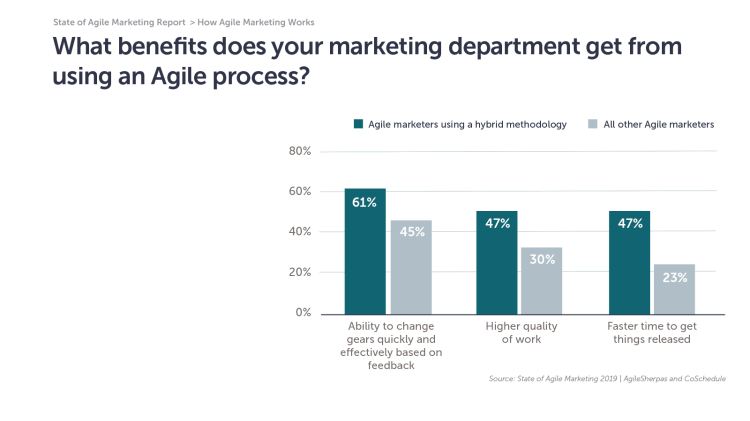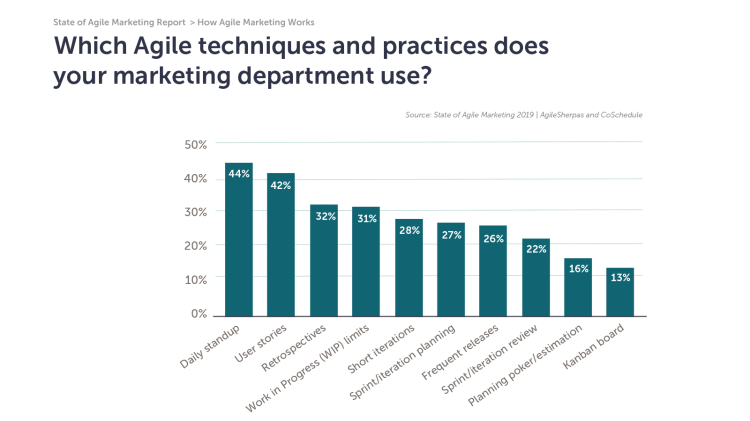Agile marketing is all the rage these days. CMOs from organizations as varied as IBM and Anheuser-Busch are singing the praises of Agile practices and the results they’re delivering.
But are marketers as a whole really making this transition?
Is the future of marketing going to be filled with daily standup meetings and kanban boards?
AgileSherpas? Second Annual State of Agile Marketing Report indicates that yes, Agile marketing has begun to infiltrate marketing teams of all shapes and sizes. The movement is young but growing fast, with half of traditional marketing teams planning to go Agile this year.
There’s a ton of data in the report, but in this first blog of a two-part series we’re going to look at what Agile marketing means and how marketers are embracing their own version of agility.
What Agile Marketing Means
First, let’s level set on what we mean by Agile marketing. You can see the full explanation in this article, but the short version is that Agile marketing is the deliberate, long-term application of a specific Agile methodology to manage and improve the way a marketing team gets work done. It requires a strategic vision, as well as short-, medium-, and long-term marketing plans.
It differs from traditional marketing in several important ways, including a focus on frequent releases, deliberate experimentation, and a relentless commitment to audience satisfaction.
For the purposes of this report, we provided the following options for respondents to choose from:
Traditional: We plan our work in advance and try to stick as closely as possible to that plan. 50% of respondents chose this one.
Agile: We use at least some parts of an Agile marketing approach to manage work, such as daily standup, a backlog, Sprints, a kanban board, etc. We have plans, but they’re flexible and change often. 32% of our marketers labeled themselves Agile.
Ad hoc: We don’t make long term plans. We work on what seems right from day to day and don’t have a well-defined process for managing incoming work. Just 15% of the marketers we surveyed say this describes them.
Marketers are Embracing Their Own Version of Agility
One of the most common (and detrimental) mistakes that I see Agile marketing teams make is assuming the Scrum methodology is their best/only Agile option for transformation of their processes.
Scrum is by far the most prescriptive Agile framework, which means that it has very strong opinions about what marketers do, when they do it, and how they interact within and among teams.
It can work for some types of marketing work, but oftentimes it’s too rigid.
Agile marketing teams who try to shoehorn themselves into Scrum can feel frustrated and overwhelmed, leading them to reject Agile outright.
Hybrid Agile Marketing Frameworks
Fortunately, the 2019 data shows that this unfortunate situation may be less common in our Agile future, as 54% of Agile marketing teams report using a hybrid framework.
Hybrid frameworks vary from team to team, but they essentially involve choosing from among all the available options and crafting a customized process.
It’s a little harder to manage, because this approach means marketers need to understand a wide variety of frameworks. I train Agile marketing teams on Kanban, Lean, Theory of Constraints, and Scrumban, as well as Scrum.
Once we know about all the available choices, we can build our own Agile adventure.
To be clear, ?hybrid? doesn’t mean using only the Agile practices that are convenient and easy.
You’ll still be making hard choices and undergoing the ever-difficult process of change, but you’ll be doing so with a larger buffet of options at your disposal.
As a bonus, you’ll also be more likely to enjoy the benefits associated with Agile marketing if you take the time to build a hybrid framework.

We found, for instance, that hybrid Agile marketing teams are twice as likely to be faster to get things released than those teams using other Agile frameworks. Results are similar for other benefits, like the ability to change gears rapidly and producing higher quality work.
Agile Marketing Practices
Speaking of practices, we also asked Agile marketers what they use day- to day to make Agile a reality on their teams.
The most popular choice is a daily standup meeting, a 15-minute huddle that allows every member of a team to quickly get up to speed on work and roadblocks. (This result brings joy to my Agile coach’s heart, as it’s one of the most impactful Agile meetings available.)

Also popular among Agile marketing teams are user stories, an alternative way of documenting work that keeps the focus on the end user or customer. User stories are typically structured in three parts: As a USER TYPE I would like A FEATURE so I can ACHIEVE AN OUTCOME.
It’s easy to translate these for marketing; there are many possible variations, including: As a PERSONA I would like A TYPE OF CONTENT so I can SOLVE A PROBLEM.
As you can imagine, user stories are a fantastic was to keep a fast-moving Agile marketing team focused intensely on their customer.
Coming in third is another Agile meeting, the retrospective.
This meeting involves only the Agile marketing team, and sets aside time to review and optimize the Agile process. It’s vital for ongoing improvement, particularly for young Agile teams just learning about how it works.
In the next blog we will discuss more about the sizes of teams going Agile and the hurdles they must overcome to do so.


